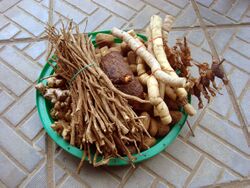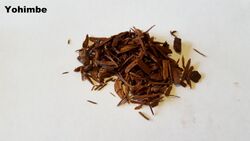Biology:Pausinystalia johimbe
| Yohimbe | |
|---|---|

| |
| Scientific classification | |
| Kingdom: | Plantae
|
| (unranked): | |
| (unranked): | |
| (unranked): | |
| Order: | |
| Family: | |
| Genus: | |
| Species: | P. johimbe
|
| Binomial name | |
| Pausinystalia johimbe (K.Schum.) Pierre ex Beille
| |
| Synonyms[1] | |
| |
Pausinystalia johimbe, (Rubiaceae), common name yohimbe, is a plant species native to western and central Africa (Nigeria, Cabinda, Cameroon, Congo-Brazzaville, Gabon, Equatorial Guinea).[1] Extracts from yohimbe have been used in traditional medicine in West Africa as an aphrodisiac and have been marketed in developed countries as dietary supplements.[2][3]
Description
Yohimbe is one of five Pausinystalia evergreen species growing in West and Central Africa in lowland forests. The tree grows about 30m tall, with a straight bole that is rarely larger than 50–60 cm in diameter. The bark is grey to reddish-brown, with longitudinal fissures, easy to peel and bitter-tasting. The inner bark is pinkish and fibrous. The sapwood is yellowish and the heartwood is ochre-yellow; the wood is fine-grained and relatively dense and moderately hard. The leaves grow in groups of three, with short (about 2 cm) petioles. The blades are oval-shaped, 11–47 cm long and 5 – 17 cm wide.[4] The demand for yohimbe bark has led to over-exploitation, with the possibility of long-term threat to sustainability of the species. Cameroon is the biggest exporter.[4]
Uses
The wood and bark are used for firewood and construction. Bark – the most commercially important product – is used in extractions to make tinctures for traditional medicine and dietary supplements.[2][4]
Human use and adverse effects
Extracts from yohimbe bark are used in West African traditional medicine in the belief that it is a herbal tonic and aphrodisiac.[2][3] Yohimbe bark and extract are used in manufactured dietary supplements, but there is no scientific evidence they have any effect, and yohimbine levels may vary substantially among supplement products.[2][3]
Although proposed as a potential treatment for erectile dysfunction in humans, there are concerns about its safety or effectiveness.[2][3] Side effects of using yohimbe, particularly in high doses, may include hypertension, increased heart rate, headache, nausea, tremors, and insomnia.[2]
Animal use
Yohimbine is used in veterinary medicine to reverse sedation in dogs, elk or deer.[3][5]
Chemistry
The main phytochemical in the extract is the indoloquinolizidine alkaloid yohimbine. It also contains other alkaloids, such as corynanthine and raubasine, with undefined properties, adding further to concerns about its safety.[2][3]
Sustainability
Over-exploitation of the tree for its bark has led to concerns that P. johimbe is becoming an endangered species.[6]
Regulation
Yohimbe bark extract has been declared as insufficiently characterized and possibly unsafe to consume by the European Union and US National Institutes of Health. Yohimbine specifically has so been declared by the European Union, but not by the US National Institutes of Health.[2][3][additional citation(s) needed]
See also
References
- ↑ 1.0 1.1 Kew World Checklist of Selected Plant Families, Pausinystalia johimbe
- ↑ 2.0 2.1 2.2 2.3 2.4 2.5 2.6 2.7 "Yohimbe". National Center for Complementary and Integrative Health, US National Institutes of Health. July 2012. https://nccih.nih.gov/health/yohimbe.
- ↑ 3.0 3.1 3.2 3.3 3.4 3.5 3.6 Beille, P. E. (2013). "Scientific Opinion on the evaluation of the safety in use of Yohimbe (Pausinystalia yohimbe)". EFSA Journal 11: 1–46. doi:10.2903/j.efsa.2013.3302.
- ↑ 4.0 4.1 4.2 R.b. Jiofack Tafokou. Pausinystalia johimbe. pp 516-519 in Timbers Volume 2; Volume 7 of Plant Resources of Tropical Africa. Eds. Lemmens, R.H.M.J., Louppe, D. & Oteng-Amoako, A.A., G.J.H Grubben. PROTA Foundation, 2012. ISBN:9789290814955
- ↑ "21 CFR Sec. 522.2670 Yohimbine". US Food and Drug Administration. 2014. http://www.accessdata.fda.gov/scripts/cdrh/cfdocs/cfcfr/cfrsearch.cfm?fr=522.2670.
- ↑ Rao, M.R.; Palada, M.C.; Becker, B.N. (2013). "Medicinal and aromatic plants in agroforestry systems". in Nain, P.K.R.; Rao, M.R.; Buck, L.E.. New Vistas in Agroforestry: A Compendium for the 1st World Congress of Agroforestry, 2004. 1. Springer Science and Business Media. p. 109. ISBN 978-9401724241.
Wikidata ☰ Q1931818 entry


